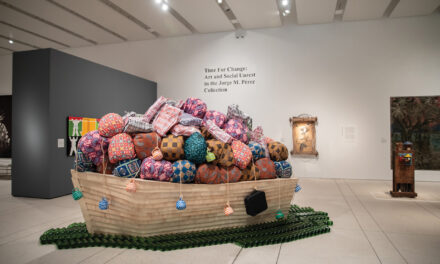
The Tampa Museum of Art is pleased to announce the opening of Oswaldo Vigas: Transformations, an exhibition celebrating one of South America’s most ambitious and celebrated modern artists. Organized by the Grand Rapids Art Museum and made possible with support from the Oswaldo Vigas Foundation and the Grand Rapids Art Museum Exhibition Society, this exhibition will be on view from now through May 27, 2019.
Oswaldo Vigas: Transformations presents the first U.S. museum survey of artist Oswaldo Vigas (Venezuelan, 1923-2014) and features 60 works of art created between 1940 and 1980, including 40 paintings and a selection of sketches and drawings. A prolific artist, Vigas found inspiration in both the natural landscape and traditions of his native Venezuela, as well as the European avant-garde. The exhibition examines the artist’s evolution as a painter and begins with Vigas’ early works, including recurring female figures inspired by Venezuelan mythology. By the 1950s, he began to explore geometric forms and color in his paintings, several of which he realized as monumental murals at the University City of Caracas (a World Heritage site). After a period of creating abstract works, Vigas returned to figuration in his later paintings, where women re-emerged in a vigorously expressive style. The works on view will illustrate the scope of Vigas’ projects, from studio painter to muralist, and demonstrate the breadth of his creative achievements.
Joanna Robotham, Curator of Modern and Contemporary Art, stated, “I look forward to introducing Oswaldo Vigas’ art to the Tampa Bay area. Vigas has been widely admired in Europe and Latin America for decades, yet is relatively new to American audiences. The exhibition Oswaldo Vigas: Transformations firmly anchors the artist as one of the 20th century’s foremost abstract painters. I am excited to share Vigas’ important paintings with our audience and present a more global view of post-war abstraction.”
The Venezuelan artist drew on a broad mixture of sources and stylistic approaches for his art, mingling indigenous South American traditions with Western modernism into a distinctly personal language. For Vigas, the spontaneity of drawing enabled him to get his ideas on paper, making it the source of his visual thinking. The imagery of Vigas’ paintings derives directly from the drawing process, whether from works he considered finished, or the experimental sketches he was constantly creating.
Born in 1923 in Valencia, Venezuela, Vigas studied medicine at Universidad de los Andes (ULA) in Mérida, Venezuela. In the 1950s, he gave up his medical practice to focus on his artwork. In 1952, he moved to Paris, where he immersed himself in the city’s stimulating post-war art scene. After twelve years there, he returned permanently to Venezuela, establishing a reputation as one of the continent’s pre-eminent artists and exhibiting his work regularly in museums across Latin America and Europe. Today, Vigas’ art resides in prominent private and museum collections including the San Francisco Museum of Modern Art; Museum of Fine Arts, Houston; and the Art Museum of the Americas. Vigas passed away in 2014 in Caracas, Venezuela.






